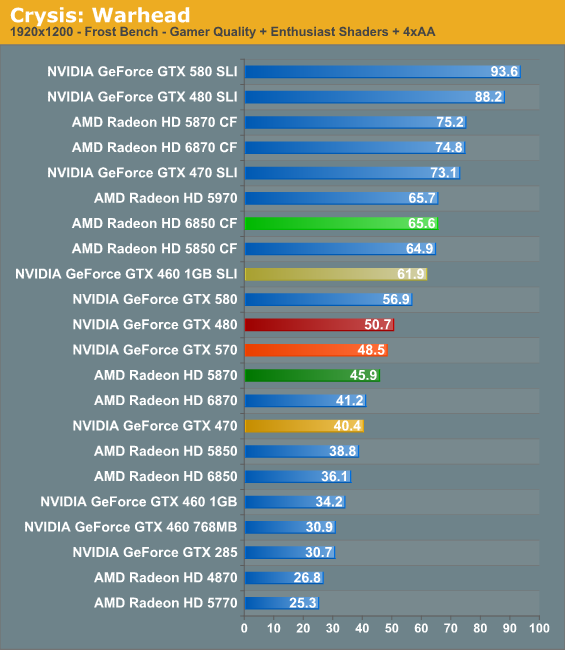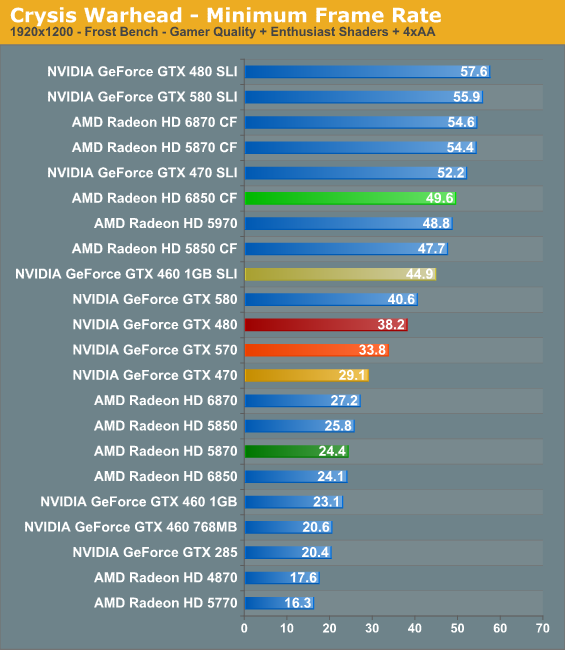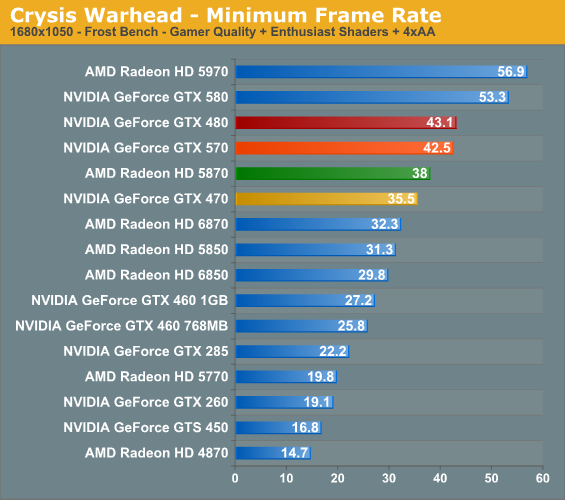NVIDIA's GeForce GTX 570: Filling In The Gaps
by Ryan Smith on December 7, 2010 9:00 AM ESTCrysis: Warhead
Kicking things off as always is Crysis: Warhead, still one of the toughest game in our benchmark suite. Even 2 years since the release of the original Crysis, “but can it run Crysis?” is still an important question, and the answer continues to be “no.” While we’re closer than ever, full Enthusiast settings at a playable framerate is still beyond the grasp of a single card.



Crysis end up setting the stage for the rest of this article. As a GTX 480 replacement the GTX 570 is effectively tied with it at 2560 and 1680, and only at 1920 do we see the GTX 570 fall behind by all of 4%. Meanwhile compared to the GTX 470 it’s 20% faster (and 40% more expensive), while it falls to the GTX 460 1GB SLI by over 10%. Overall the GTX 570 is at near parity with the GTX 480, and should be equally capable of playing just about everything at 1920.
As for AMD’s cards, the 5870 (which was never too far behind the GTX 480) nips at the GTX 570’s heels – at times the GTX 570 is no more than 5% faster and no better than 15% faster, showcasing why the 5870 is a threat to the GTX 570 as a value threat. Meanwhile the 6850 CF is tops here at 1920 by a wide margin for only around $20-$30 more than the GTX 570. As was the case with the GTX 580, a pair of lesser AMD cards is going to offer better gaming performance in exchange for the drawbacks of a multi-GPU setup.



Looking at our minimum framerates, the story is much the same. Outside of 2560 where the extra memory provides a stark advantage for the NVIDIA cards, the GTX 570 and GTX 480 are close together except for 1920 where the 570 falls behind by a bit more than we’d expect. The 5870 isn’t nearly as threatening here as it is with average framerates, but the 460SLI/6850CF configurations are still well ahead.










54 Comments
View All Comments
xxtypersxx - Tuesday, December 7, 2010 - link
If this thing can hit 900mhz it changes the price/performance picture entirely, why no overclock coverage in such a comprehensive review?Otherwise great write up as always!
Bhairava - Tuesday, December 7, 2010 - link
Yes good point.vol7ron - Tuesday, December 7, 2010 - link
Why do graphics cards cost more than cpu+mobo these days?I know there's a different design process and maybe there isn't as much an economy of scale, but I'm just thinking about the days when it was reverse.
Klinky1984 - Tuesday, December 7, 2010 - link
Well you're essentially buying a computer on a card with a CPU these days. High performance GPU w/ high performance, pricey ram, all of which needs high quality power components to run. GPUs are now computers inside of computers.lowlymarine - Tuesday, December 7, 2010 - link
I think it's simply that GPUs can't get cheaper to the extent that CPUs have, since the die sizes are so much larger. I certainly wouldn't say they're getting MORE expensive - I paid $370 for my 8800GTS back in early 2007, and $400 for a 6800 in early 2005 before that.DanNeely - Tuesday, December 7, 2010 - link
High end GPU chips are much larger than high end CPUchips nowdays. The GF110 has 3bn transistors. For comparison a quadcore i7 only has 700m, and a 6 core athlon 900m, so you get 3 or 4 times as many CPUs from a wafer as you can GPUs. The quad core Itanic and octo core I7 are both around 2bn transistors but cost more than most gaming rigs for just the chip.GDDR3/5 are also significantly more expensive than the much slower DDR3 used by the rest of the computer.
ET - Tuesday, December 7, 2010 - link
They don't. A Core i7-975 costs way more than any graphics card. A GIGABYTE GA-X58A-UD9 motherboard costs $600 at Newegg.ET - Tuesday, December 7, 2010 - link
Sorry, was short on time. I'll add that you forgot to consider the price of the very fast memory on high end graphics cards.I do agree, though, that a combination of mid-range CPU and board and high end graphics card is cost effective.
mpschan - Wednesday, December 8, 2010 - link
Don't forget that in a graphics card you're getting a larger chip with more processing power, a board for it to run on, AND memory. 1GB+ of ultra fast memory and the tech to get it to work with the GPU is not cheap.So your question needs to factory in cpu+mobo+memory, and even then it does not have the capabilities to process graphics at the needed rate.
Generic processing that is slower at certain tasks will always be cheaper than specialized, faster processing that excels at said task.
slagar - Wednesday, December 8, 2010 - link
High end graphics cards were always very expensive. They're for enthusiasts, not the majority of the market.I think prices have come down for the majority of consumers. Mostly thanks to AMDs moves, budget cards are now highly competitive, and offer acceptable performance in most games with acceptable quality. I think the high end cards just aren't as necessary as they were 'back in the day', but then, maybe I just don't play games as much as I used to. To me, it was always the case that you'd be paying an arm and a leg to have an upper tier card, and that hasn't changed.